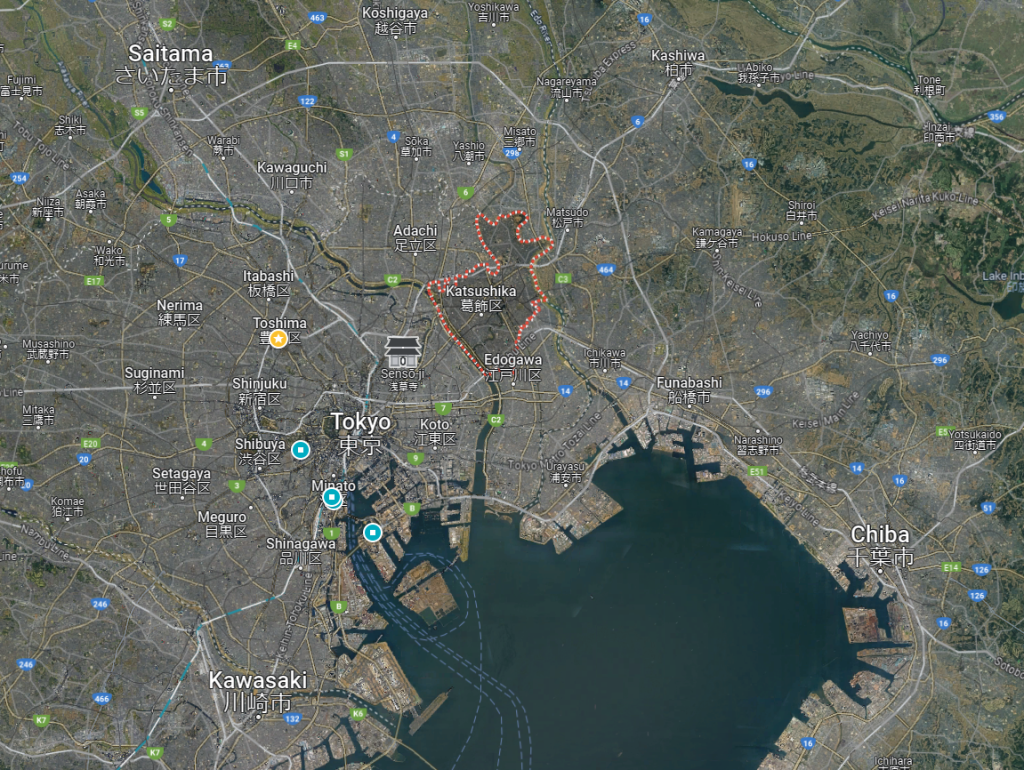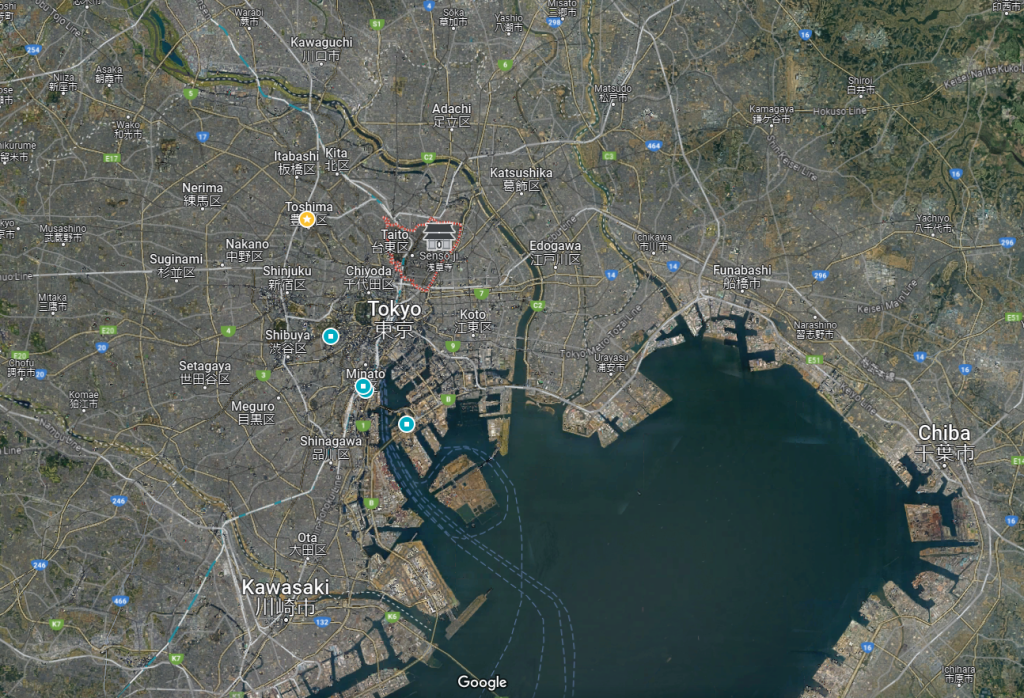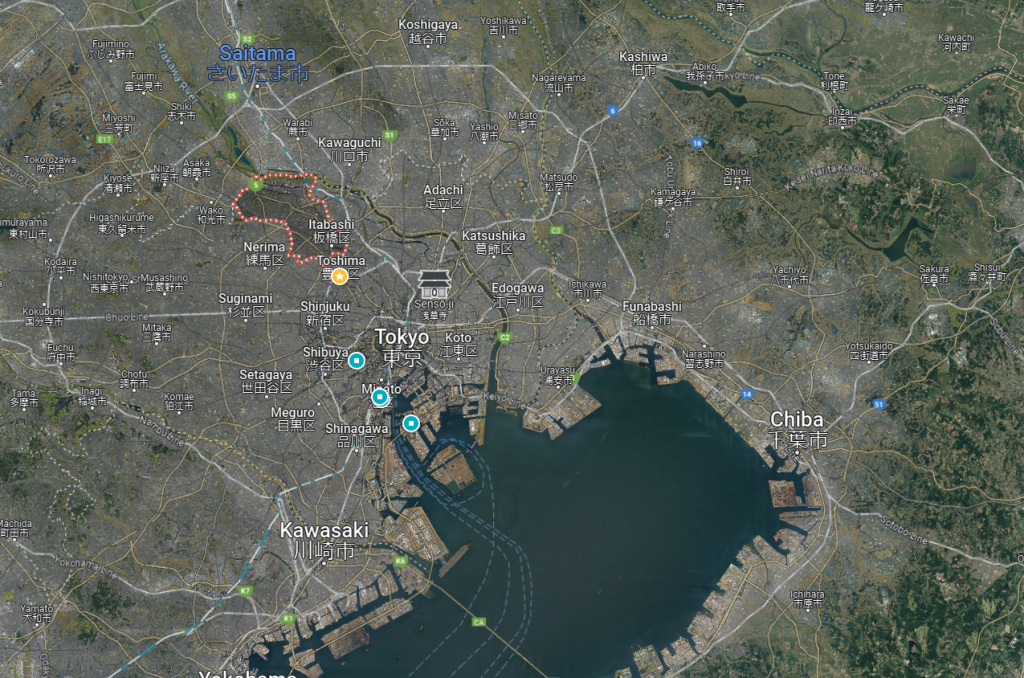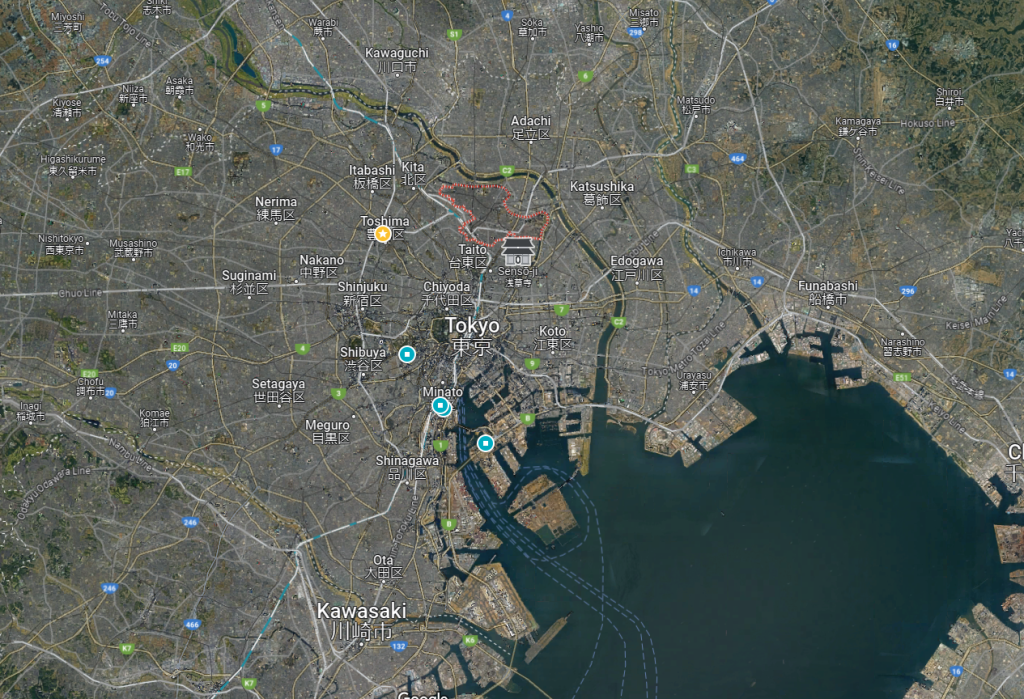A break down of the cheapest places to live in Tokyo
Tokyo is known for being one of the most expensive cities in the world. However, this doesn’t mean that living in Tokyo has to break the bank. In this article, I take a look at some of the more affordable neighborhoods that offer a balance of convenience, culture, and cost-effectiveness. I focus on essential aspects of living costs, including rent, food, transportation, and utilities, providing an introductory guide for those looking to make Tokyo their home without sacrificing their savings.
What are the most affordable neighborhoods in Tokyo for expats?
Tokyo, a city renowned for its blend of ultramodern and traditional, from neon-lit skyscrapers to historic temples, also carries a reputation for high living costs. However, amidst this bustling metropolis lie neighborhoods that offer a reprieve from the financial demands of city living, making them ideal for expats seeking affordability without sacrificing the Tokyo experience.
Katsushika Ward: A Glimpse into Traditional Tokyo

Katsushika Ward, located in the eastern part of Tokyo, is known for its lower cost of living compared to the city center. It offers a glimpse into traditional Japanese culture with its historic temples and the famous Shibamata Taishakuten, a Buddhist temple. The area is also home to the annual Sumida River Fireworks Festival, adding to its cultural richness.
Adachi Ward: Affordable Living with a Community Feel

Adachi Ward, another affordable option, is characterized by its community feel and access to numerous parks and rivers, providing a serene environment away from the hustle and bustle of central Tokyo. The area offers a variety of housing options at lower costs, making it a practical choice for expats.
Taito Ward: Cultural Richness at a Lower Cost

Taito Ward, though slightly more expensive than Katsushika and Adachi, is still considered affordable. It is home to the famous Asakusa district, Ueno Park, and several museums. Taito provides a balance of cultural richness and affordability, making it an attractive option for those wanting to experience the heart of Tokyo’s history and culture without the steep price tag.
Itabashi Ward: Convenience and Affordability

Itabashi Ward offers a blend of convenience and affordability. Its location provides easy access to central Tokyo while maintaining a lower cost of living. The area is well-served by public transportation, making it an ideal choice for expats working in the city center but seeking more budget-friendly living options.
Arakawa Ward: A Mix of Culture and Affordability

Arakawa Ward is known for its mix of cultural attractions, such as the Arakawa Amusement Park and Nippori Fabric Town, and affordable living options. The ward offers a variety of housing choices at reasonable prices, catering to different needs and preferences.
Tokyo’s reputation for high living costs doesn’t mean that affordable options aren’t available. Neighborhoods like Katsushika, Adachi, Taito, Itabashi, and Arakawa Wards offer expats the opportunity to enjoy the Tokyo experience without breaking the bank. These areas not only provide affordable housing but also enrich residents’ lives with their unique cultural and community aspects.
For expats willing to explore beyond the city center, Tokyo’s more affordable neighborhoods prove that living in this vibrant city can be both economically viable and culturally enriching.

From Tatami to Tokyo: The Foreigner’s Handbook Apartment Hunting in Japan” is a comprehensive guide designed to navigate foreigners through the complexities of finding an apartment in Japan. The book covers a wide range of topics essential for understanding the Japanese rental market, including a historical overview of landlords and apartments, the importance of realtors, the apartment search process, financial considerations, finding a guarantor, dealing with NHK officials, and cultural aspects relevant to renting in Japan. It also provides practical advice on using moving companies once an apartment has been secured. The main focus or theme of the book is to assist foreigners in apartment hunting in Japan, offering insights into the unique challenges and requirements of the Japanese housing market.
How does the cost of living in Tokyo’s cheaper areas compare to the city center?
Tokyo, a city known for its dynamic blend of tradition and modernity, is also infamous for its high cost of living. However, for those willing to venture beyond the bustling city center, there are several neighborhoods that offer a more affordable alternative without compromising on quality of life.
Cost Disparities: City Center vs. Suburban Areas
The cost of living in Tokyo’s city center, including popular districts like Shibuya, Shinjuku, and Chiyoda, is notably higher compared to suburban areas. Rental prices for apartments and houses in the city center can be significantly more expensive due to the prime location and proximity to major business and entertainment hubs. On the other hand, suburban areas such as Katsushika, Adachi, and Itabashi Wards offer more budget-friendly housing options, making them an attractive choice for those seeking to reduce their living expenses.
Housing Options: High-Rise Apartments vs. Low-Rise Residences
In the city center, high-rise apartments are a common sight, offering modern amenities and convenient access to urban facilities. However, these come with a premium price tag. In contrast, suburban areas often feature low-rise residences, including traditional Japanese houses (machiya) and smaller apartment buildings. While these may lack some of the luxuries found in high-rise complexes, they provide a more economical housing solution for residents.
Daily Expenses: Dining, Shopping, and Entertainment
The cost of daily expenses such as dining, shopping, and entertainment also varies between the city center and suburban areas. Restaurants and stores in the city center tend to charge higher prices due to the demand from tourists and affluent locals. In comparison, suburban neighborhoods offer more affordable dining options, local markets, and community-oriented entertainment venues, allowing residents to save on their day-to-day expenditures.
Transportation Costs: Proximity vs. Commuting
One of the significant factors contributing to the cost of living is transportation. Residents in the city center may enjoy the convenience of walking or using public transport for their daily activities, but this comes with a higher price due to the proximity to major attractions and business districts. In contrast, suburban residents may need to commute longer distances to reach the city center but can benefit from lower transportation costs, especially if they use commuter passes or live close to train stations with direct access to central Tokyo.
What are the hidden costs of living in Tokyo’s more affordable districts?
The hidden costs of living in Tokyo’s more affordable districts include longer commutes, smaller living spaces, and potential compromises in lifestyle. While housing in the suburbs or neighboring cities can be significantly cheaper than in the heart of Tokyo, the trade-off is often longer commutes, which can be tiring, especially given the long work hours common in Japan.
Additionally, more affordable apartments in Tokyo may be smaller, with a single room serving as a bedroom, living room, and kitchen, and they may lack modern amenities such as air conditioning or elevators. The cost of living in Tokyo’s wards, even in more affordable areas, is still relatively high compared to other parts of the country. Therefore, while living in these districts may offer cost savings on housing, individuals may need to consider the impact on their overall quality of life, including factors such as commute time and living space.
What are the safety levels like in Tokyo’s most affordable neighborhoods?
Tokyo is widely recognized as one of the safest cities in the world, and this extends to its various neighborhoods. When considering the crime rate, which is a specific aspect of safety, it’s important to look at both the statistics for crime and the types of crime that are most prevalent.
Crime Statistics in Tokyo Neighborhoods
According to the Tokyo Metropolitan Police Department’s records for 2017, there were several neighborhoods within the 23 Wards of Tokyo that reported very low crime rates. For example, 27 neighborhoods tied for the safest place, with only one reported crime for the entire year. Some of these neighborhoods include Katamachi in Shinjuku Ward, Chitose 1-Chome in Sumida Ward, and Yanaka 5-Chome in Taito Ward, where the reported crimes were categorized as theft (not involving breaking & entering).
Affordable Neighborhoods with Low Crime Rates
While the resources provided do not directly correlate affordability with crime rates, it is reasonable to infer that some of the neighborhoods with low crime rates may also offer affordable living options. For instance, areas like Nakazatocho in Shinjuku Ward and Yanaka 5-Chome in Taito Ward are mentioned as having low crime rates and may have mid-range to high-end apartment options nearby.
Perception of Safety
It’s also worth noting that the perception of safety can vary among locals and visitors. For example, some areas like Shinjuku, Ikebukuro, and Shibuya are known for being busier and having more nightlife, which can sometimes be associated with higher crime rates. However, walking at night is generally safe, and staying a little distant from the big stations can increase one’s sense of safety.
Overall Safety in Tokyo
Tokyo is widely recognized as one of the safest cities in the world, and this extends to its various neighborhoods. When considering the crime rate, which is a specific aspect of safety, it’s important to look at both the statistics for crime and the types of crime that are most prevalent.
When comparing schools and educational facilities in cheaper versus more expensive areas of Tokyo, there are several factors to consider, including the type of school (public vs. private and international vs. local), class sizes, curricula, facilities, extracurricular activities, and costs.
Comparison of Educational Facilities in Tokyo
Public Schools
- Cost: Public schools in Tokyo are funded by the government and generally have lower tuition fees or are entirely tuition-free.
- Class Size: They tend to have larger class sizes, which may mean less individual attention for each student.
- Curriculum: Public schools follow government-mandated curricula and emphasize academic excellence.
- Diversity: They offer a diverse student body, exposing children to a broader range of perspectives and backgrounds.
- Cultural Immersion: Public schools provide an opportunity for students to immerse themselves in Japanese culture, language, and customs.
Private Schools
- Cost: Private schools come with higher tuition fees but may offer scholarships and financial aid options.
- Class Size: They are known for smaller class sizes, which allows for more personalized attention and greater teacher-student interaction.
- Curriculum: Private schools have more flexibility in designing their curricula, which can cater to specific interests and learning styles.
- Facilities: Many private schools boast advanced facilities and resources, providing a more enriching educational experience.
- Extracurricular Activities: A broader range of extracurricular activities is available, fostering well-rounded development.
International Schools
- Cost: International schools are generally more expensive than both public and private local schools, with tuition fees ranging from approximately JPY 1,500,000 to JPY 3,000,000 per year.
- Curriculum: They offer curricula that may be more aligned with international standards, such as the International Baccalaureate (IB) or the curricula of other countries.
- Language: Instruction is often in English or other major languages, which can be beneficial for expatriate families or those seeking an international education for their children.
- Global Perspective: Students gain exposure to international cultures and can earn credits that are recognizable in other countries.
Cost Comparison
The cost of education in Tokyo varies significantly between public, private, and international schools. Private education costs can be more than three times as expensive as attending public school, with a particularly notable gap at the elementary school level. International schools tend to be at the higher end of the cost spectrum.
Location and Quality of Education
While the search results do not provide specific comparisons between cheaper and more expensive areas of Tokyo, it is generally observed that in many cities around the world, schools in more affluent areas may have access to more resources, leading to better facilities and extracurricular offerings. However, this is not a strict rule, and there are high-quality educational institutions across the entire city.
What are the best resources for finding affordable housing in Tokyo?
Apartments
For those looking for budget apartments, exploring options outside the city center can lead to more affordable finds. Western suburbs like Machida, as well as neighboring prefectures such as Saitama and Chiba, offer lower rental prices. Websites like Real Estate Japan provide listings for budget apartments, with examples including furnished studio apartments in areas with good access to central Tokyo, such as Koenji and Kita Senzoku, for around ¥65,000 ($550) a month. It’s important to note that most rental apartments in Japan charge a monthly maintenance fee, which adds to the overall cost.
Shared Housing
Shared housing or share houses are popular among both locals and foreigners for their affordability and social environment. Oakhouse and BORDERLESS HOUSE are two providers that offer foreigner-friendly share houses in Tokyo with no agency fee, deposit, key money, or guarantor required. These share houses often come with furnished rooms and communal areas, making them a convenient option for new arrivals in Japan.
Dormitories
For students and sometimes young professionals, dormitories can be an economical choice. While specific dormitory listings were not provided in the search results, universities in Tokyo often provide or can recommend affordable dormitory options for their students. Additionally, language schools and some companies also offer dormitory-style accommodations for their students or employees.
Additional Tips
- Neighborhoods: Consider neighborhoods that balance affordability with convenience. Areas like Nerima, Adachi, and Katsushika wards are known for their lower rental prices while still offering reasonable access to central Tokyo.
- Initial Costs: Be mindful of initial move-in costs, which can include key money, deposit, and agency fees. Some listings specifically advertise no key money or deposit required, which can significantly reduce upfront expenses.
- Websites and Resources: Utilize English-friendly rental websites like GaijinPot, which caters to foreigners looking for housing in Japan and offers a wide range of rental options across different budgets.

Your article helped me a lot, is there any more related content? Thanks!
Your point of view caught my eye and was very interesting. Thanks. I have a question for you.
Thanks for sharing. I read many of your blog posts, cool, your blog is very good.
Thanks for sharing. I read many of your blog posts, cool, your blog is very good.
Thanks for sharing. I read many of your blog posts, cool, your blog is very good.
Your article helped me a lot, is there any more related content? Thanks!
I don’t think the title of your article matches the content lol. Just kidding, mainly because I had some doubts after reading the article.
Thanks for sharing. I read many of your blog posts, cool, your blog is very good.
Thanks for sharing. I read many of your blog posts, cool, your blog is very good.
Thank you for your sharing. I am worried that I lack creative ideas. It is your article that makes me full of hope. Thank you. But, I have a question, can you help me? https://accounts.binance.com/en-NG/register-person?ref=JHQQKNKN
I don’t think the title of your article matches the content lol. Just kidding, mainly because I had some doubts after reading the article.
Your point of view caught my eye and was very interesting. Thanks. I have a question for you.
I don’t think the title of your article matches the content lol. Just kidding, mainly because I had some doubts after reading the article.
Thank you, your article surprised me, there is such an excellent point of view. Thank you for sharing, I learned a lot.
I don’t think the title of your article matches the content lol. Just kidding, mainly because I had some doubts after reading the article.
Your article helped me a lot, is there any more related content? Thanks!
Can you be more specific about the content of your article? After reading it, I still have some doubts. Hope you can help me.
Thank you for your sharing. I am worried that I lack creative ideas. It is your article that makes me full of hope. Thank you. But, I have a question, can you help me?
Thank you for your sharing. I am worried that I lack creative ideas. It is your article that makes me full of hope. Thank you. But, I have a question, can you help me?